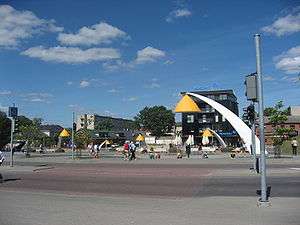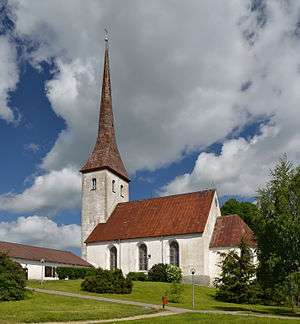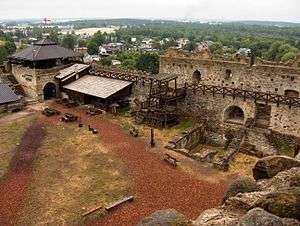Rakvere
Rakvere (Tarbapea in ancient Estonian, Weisenberg in German, Rakowor in Russian) is Estonia’s fifth largest city and situated the northern part of the country, 20 km south of the Gulf of Finland and approximately 100 km east of Tallinn, Estonia.
Understand

Its earliest signs of human settlement date back to the 3rd-5th century.
Nowadays, Rakvere is an attractive and rapidly developing town with quite an interesting character. The modern Rakvere perfectly reflects the phenomenon of the Estonian province: with visible lowliness and calm, a turbulent cultural life flows here. Every day there is a play or a movie in the theatre, there are a lot of cafés and restaurants in the city, and the architecture is diverse and quite original.
Rakvere is the place where the first Estonian Punk Song Festival took place. It’s also the host to the well-known international rock music festival “Green Christmas.” Since 1994, a biannual international theatre festival, called Baltoscandal has taken place in the unique, friendly and slightly crazy atmosphere of Rakvere. The city is also known in Estonia for its youthful hip-hop and electronic music scene. So it’s no wonder, that the motto of Rakvere is “full of power”.
More information: http://rakvere.kovtp.ee/
- 🌍 Tourist Information Centre, Laada tn 14, ☎ +372 324 27 34, fax: +372 324 27 34, e-mail: rakvere@visitestonia.com. M-F 09:00–17:00 (break 13:00–14:00). When closed, a sign on the door suggests to take a look at the printouts of the city maps, posted in the window to the right of the entrance.
Get in
Bus and train schedules are easily available online – read more under Estonia#Get around.
By bus
- 🌍
Rakvere Bus Station, Laada 18a. 06:45–20:00. Modern glass pavilion with benches, cash desks and R-kiosk. The schedule is displayed above the ticket offices, so it can be read directly from the street. However, it is arranged in a completely mysterious way, contrary to any principles of design and structuring of information.
Rakvere has regular bus connections to Tallinn (every hour, 1.5 hr), Tartu (every two hours, 2 hr 10 min) Narva (every two hours, 2.5 hr), Jõhvi and to a number of other cities.
By train
- 🌍
Rakvere Railway Station, Jaama 6a (1 km to the north-east of the city centre). The building of the station is actually a shop, so you might believe that no trains go from here. Unfortunately, the original building of the station in Rakvere was not preserved.
Edelaraudtee runs a Tallinn-Narva train twice a day, which stops in Rakvere, and another train just to Rakvere (1 hr 20 min). With their help you can come to the city in the morning and return to Tallinn in the evening.
GoRail also operates the Tallinn-Moscow line, which also stops in Rakvere.
By car
Rakvere is a short distance from the Tallinn-Narva road and the Rakvere-Pärnu road #5. Tallinn 100 km, Narva 116 km, Tartu 133 km.
Get around
The major landmark is the castle and its mountain, which stretches from north to south, along Pikk Street to the west – the most historic part of the city. The central square (Turu plats) is located in a couple of blocks to the east.
By foot
Most attractions of Rakvere are within walking distance. The most distant point of interest is the railways station in the north of the city.
By bus
The public transport buses are operated by GoBus Rakvere – there is a total of 5 bus lines. All of them go at intervals every hour and are unlikely to be useful to the traveler, as the sights are in walking distance.
See

- 🌍 "Tarvas" Bull Statue (Tarva kuju / Wild Herbivore), Kreutzwaldi 1 (located near the old castle ruins). It’s considered to be the largest animal statue in the Baltics. According to the legend, there was an ox once in the world the size of the distance between Tartu and Rakvere, which destroyed everything in its way. One day it was killed, and his head fell down in Rakvere. So, the city began to be called Tarbapea (bull's head), and the rest fell to Tartu, called Tarbatu (bull). The attitude of the Tartu inhabitants to this legend is cautiously silent.
- 🌍 Rakvere's town square (Turu plats). A small square in the centre of Rakvere, and probably the most modern in Estonia. It was completely renovated in 2004, when strange yellow canopies resembling, either umbrellas or lampshades, were installed here. In 2010, the city sculpture "Young man on bicycle listening to music" was added to the umbrellas. It is dedicated to the citizen Arvo Pärt, an Estonian composer who grew up in Rakvere. Nowadays, daily at noon, his music is played by the Church of the Holy Trinity. The symbolism of all these objects is not quite clear. When resting under the umbrella, pay attention to the bank building (Turu plats 2, 1932-33) – a monument of functionalism architecture – as well as the yellow market building (Laada tn 14, 1926-28), an example of Art Deco – semicircular arches, numerous tiers with multi-sized windows and a rectangular tower were intertwined. All quite fascinating, and the building can easily be taken for the town hall or station, but not for the market, which, however, has not been here for a long time.
- 🌍 Lutheran Church of the Holy Trinity (Rakvere Kolmainu kirik), Pikk 19, ☎ +372 3243928, +372 5513771, e-mail: rakvere@eelk.ee. This is a late medieval church with an unusually high and slender spire that was built in the 17th century. Built at the beginning of the 15th century, the church was a shelter during the Livonian war (1558-1583), during which it suffered a lot of damage. The nave of the church was even in a state of collapse due to the demolition. However, it was reconstructed between 1684-1693 as a three-nave chamber church. Between 1703-1708 it was burnt twice, and later rebuilt between 1727-1730. The existing spire of the church was built in 1852. The part made of stones is 37.8 m in height, but the church has a total height of 62 m. The church's history is related to grave marker of Bishop Arnoldus H. Annabat. Eye-catching Baroque fretwork masterpieces – the pulpit and altar wall, can be found inside, besides other art objects.
- 🌍 Orthodox Church of the Nativity of Theotokos (Christmas Church / Church of Nativity of the Most Holy Mother of God / Estonian Orthodox Chruch of Moscow Patriarchate / MPEÕK Rakvere Jumalaema Sündimise kirik), Tallinna 17, ☎ +372 51921272. 10:00–16:00. The original church was a two-storey building purchased according to an order of the Russian Emperor Nicholas I and the Most Holy Synod in 1839. Parishioners of the church were families of the orthodox merchants, city officials, teachers of the local educational institutions, and soldiers of border guards. From the middle of the 19th century the size of the parish was increased by Estonian peasants, who had adopted the Orthodox faith. It was completely rebuilt at the beginning of the 20th century. Consecration of the temple was done by the Archbishop of Riga and Mitava Agaphangel (Preobrazhensky). Nowadays, it looks like a strange, very provincial, rather boring variation of the pseudo-Russian style, but it looks very unusual for the Baltic landscape. The interior is modest and mostly wooden, containing the holy remains of the martyred priest Sergei Florinski (Sergius of Rakvere), brought here in 2003, which are the only public holy remains in Estonia. Sergei was a chaplain, who was shot by the order of Estonian Labour Commune in Rakvere on December 30th, 1918.
- 🌍 The Church of St. Paul, Võimla tn 1. From a distance this building resembles a workshop. In fact, it is a church built in the late 1930s in the style of radical radicalism. For obvious reasons, the decoration did not have time to finish: the building is unplastered and the towers were left without completion. In Soviet times, the church was converted into a gymnasium, which is located here to this day. A more 🌍 humanistic functional church (1933) can be seen on the next street (Koidula 15) – a pretty wooden building with perfect geometric shapes.
- 🌍 Rakvere Citizen's House Museum (Rakvere Linnakodaniku muuseum), Pikk 50, ☎ +372 3244248. Tu-Sa 11:00–17:00 (until 15:00 in winter). Museum of folk life, recreating the situation and occupation of the inhabitants of Rakvere in the first half of the 20th century. €1.60 (2013).
- 🌍 Estonian Police Museum (Eesti politseimuuseum), Tallinna 3, ☎ +372 3225503. Tu-Sa 10:00–18:00. A largely interactive museum, designed to tell visitors about the daily work of police. You can check your reaction behind the wheel of a car, take fingerprints, or look at a forensic laboratory. For children this will be especially interesting. €6 (2013).
- 🌍 Rodewal Manor, Vahtra allee (behind the railway station). A country estate on the edge of Rakvere. The wooden manor house was built in 1864 and with interestingly carved decoration of snakes on the pediment.
- Pikk Street – Completely preserved pre-revolutionary buildings, a kind of "assorted": stone mansions of the Russian type, typical for the Baltic wooden houses and, of course, the ubiquitous brick style. Particularly interesting are the one-storey mansion of the 18th century, later designed for modernity (Pikk 16), a wooden building of optics from 1887 with intricate carvings (Pikk 17), and a wooden dwelling house of the late 18th century (Pikk 21).
- Wooden architecture – In addition to the various houses of the 19th century – more interesting from the ethnographic point of view – there are very nice buildings in the spirit of Art Deco. This includes the county government (Fr. R. Kreutzwaldi 5, opposite the theatre), the apartment houses Koidula 4 and Adoffi 3 near the central square (Kastani 17), and the kindergarten (Koidula 14). These houses were built during the inter-war period.
- Pre-revolutionary stone architecture – Represented by the dark red building of the court (Tallinna tn 3, 1786-87), where the exhibition house is now located, and the neighbouring manor house (Tallinna tn 5), in which the city administration is located. Go to the arch and into the yard – there are still some manor buildings of a completely German type. Another more monumental courthouse can be found at Lai 6, built at the end of the 19th century.
Do

- 🌍 Rakvere Order Castle (Burg Wesenberg), Vallimägi, ☎ +372 3225502, +372 5076183, e-mail: helina@svm.ee. Mar/Apr/Oct W-Su 10:00-16:00, May/Sept daily 10:00-18:00, Jul-Aug daily 10:00-19:00, in winter on group request. The first fortifications on the castle hill appeared at the beginning of the 13th century, when conquered by the Danes. In those years there was either a wooden one, or an unpretentious stone fortress, which the Russians tried to capture. After the transition of Estonian lands from Denmark to the Livonian Order, in the middle of the fourteenth century, a large, well fortified castle was built on the site of the old one. Some fragments can still be seen to this day. At the turn of the 16th-17th centuries, the castle was destroyed in the course of numerous wars between Sweden, Poland, and Russia. Afterwards, the locals used the ruins as a source of stone, until the first attempts of restoration began at the beginning of the 20th century. However, the main restoration was already in the late 1970s. Nowadays, it is something in between ruins and a full-fledged castle. The castle is very picturesque (inside and outside). To get inside you will have to buy a rather expensive ticket, which includes various amusements like archery, smithy, ancient armour, and the notorious "hell" chamber. In the summer, the castle works in a medieval style tavern (with no potatoes), but if its visit is not included in your plans, you can confine yourself to an external examination. Regular visit: €9/7 adult/discount (one can bargain down to discount, pretending not to be interested).
- 🌍
Rakvere Teatre, Kreutzwaldi 2a, ☎ +372 3295444. On the weekends there are usually performances, on weekdays - cinema, and in the cafe sometimes arrange concerts. The pride of the locals. It is believed that Rakvere is the smallest city in the world, which has its own theatre and theatrical company. This location is the historical centre of Rakvere: ancient Estonian settlements were located here, and it also features the Rakvere Cultural Center. Formerly a classical farmstead, it was converted to a theatre in 1940 with the addition of a new building. Although, the manor and the theatre are made in completely different styles (the theatre itself is impregnated with the spirit of functionalism), they look surprisingly harmonious. Behind the building a pretty landscape park with ponds can be found.
The repertoire of the theatre are 20 productions, although it is not very clear who in Rakvere works on them. - 🌍 Rakvere Spordikeskuses, Kastani 12. A modern sports complex, to which the stadium adjoins. Inside the gyms, climbing wall, mini-golf course and, of course, a sauna.
- 🌍 Aqva Hotel&Spa, Parkali 4. 09:00–22:00. A swimming pool, water park and sauna. It is not necessary to spend the night in the hotel. It is much cheaper to settle in a more modest place and go for a couple of hours to swim. €8-12 for 2.5 hr (2013).
Buy
Rakvere has got several big shopping centres both for clothes and home electronics.
- 🌍 Marit Käsitöö (Handicraft), Pikk 12. M-F 09:00–17:00, Sa 09:00–14:00. National clothes and jewellery.
- 🌍 Viru Handicraft, Pikk 16. M-F 09:00–18:00, Sa 09:00–15:00. National clothes.
- 🌍 Lõnga Liisu OÜ, Tartu mnt. 11, Pajusti (10 km southeast of Rakvere), ☎ +372 5121214. M-F 08:00–16:30. This small private enterprise sews clothes in national style, and not only suits of rural residents of the beginning of the 20th century. Also regular sweaters and sweaters with a pretty pattern.
Eat
- 🌍 Hagari pizza (Päts pitsakohvik), Vilde 4 (opposite the bus station), ☎ +372 3223799, +372 5090700. On weekdays they have a very cheap daily menus. The rest of the time it is slightly more expensive. The situation in Hagari pizza is simple, but pleasant. In addition to pizza, soups and a few hot dishes are on the menu. Pizza from €2.50, hot dishes from €4 (2013).
- 🌍 Laada Café, Laada 10A, ☎ +372 5289835. M-Sa 07:30–21:00, Su 10:00–19:00. A city café with a pleasant interior and surprisingly low prices. There are simple and quite cheap meals like pancakes. But you can also order a full-fledged hot dish. Hot dishes: €4-6, pasta from €3 (2013).
- 🌍 Puhkepaik, Laada 14, ☎ +372 53716767. M-F 09:00–17:00, Sa 10:00–17:00. Cafeteria in the central square, the next door to the tourist information centre.
- 🌍 Sako kohvik, Tallinna 14. Typical Estonian dining room. FB. Main courses: €2-3 (2013).
- 🌍 Theatrical café (Rakvere Teatrikohvik), Kreutzwaldi tn 2A, ☎ +372 3295420. 09:00–23:00. This is not a theatre buffet, but quite an independent café. Sandwiches and pastries. Hot food 11:30–17:00.
- 🌍 Pihlaka Café, Parkali 7, ☎ +372 3245062. 08:00–20:00. Café at the local confectionery factory with a huge selection of cakes and pastries. They also have a hot meal.
- 🌍 Virma Pubi, Tallinna 8, ☎ +372 3223907. Su-W 12:00–23:00, Th 12:00–01:00, F-Sa 12:00–04:00. Colourful pub, which from time to time turns into the centre of urban entertainment. On weekends, live music and 1980s disco. There is also pool billiard. FB. Main courses: from €7 (2013).
Drink
- 🌍 Kära Kants (Hard Rock Pub), Tallinna 28, ☎ +372 3223819. M-Th 18:00–24:00, F-Sa 18:00–04:00. Heavy Metal/Rock Bar, in the basement not far of a walk from the castle, popular with bikers and head-bangers. The bar is prudently located in the basement of the police building. Has a pool table and a great selection of beer. Great atmosphere on weekends, but is open all week.
- 🌍 Mjau, Kreutzwaldi 1, ☎ +372 55536505, e-mail: mjau@mjau.ee. F-Sa 21:00–05:00. A nightclub and a "music salon". FB.
Sleep
Budget accommodation is sparse in Rakvere. Better try the surrounding villages, or head for one of the observation towers in Lahemaa National Park.
- 🌍 Villa Theresa, Tammiku 9, ☎ +372 3223699, e-mail: info@villatheresa.ee. Guest house with rooms decorated in old style with a nearby and cosy restaurant. Good feedback, and 20% discount on the AQVA SPA.
Go next
- Tallinn – The capital, and financial and cosmopolitan centre of Estonia, with a medieval Old Town. Beautiful and expensive.
- Jõhvi – The capital of the county, but rather uninteresting from a travellers point of view.
- Püssi – A poor but now recovering town with an interesting artificial mountain made of ash from its oil shale power plant, which has been depositing ash in the location since the 1930s. Nowadays, the mountain is used for motocross.
- Käsmu – A coastal village inside of Lahemaa National Park.
- Võsu – A coastal small borough inside of Lahemaa National Park.
- Narva – Estonia's eastern-most and third largest city, on the Narva River, which is the border with Russia. Famous for the Hermann castle, right opposite of the Ivangorod's castle, and the Kreenholm factories. Even though it might seem grey and dull.